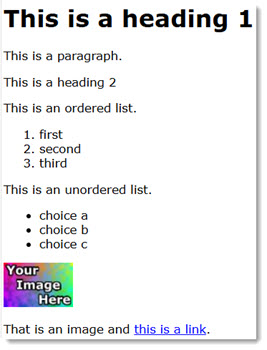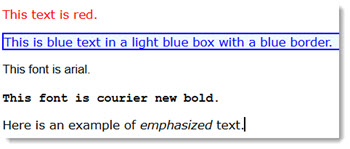The Plain Text Editor requires a basic knowledge of HTML and CSS code. Menus of advanced features are available to insert custom or dynamic content into your message.
Basic code
Below are basic examples of HTML and CSS to help you get started. Detailed guidance for writing HTML and CSS is available from many sources online.
 HTML
HTML
<h1>This is a heading 1</h1>
<p>This is a paragraph.</p>
<p>This is a heading 2</p>
<p>This is an ordered list.</p>
<ol>
<li>first</li>
<li>second</li>
<li>third</li>
</ol>
<p>This is an unordered list.</p>
<ul>
<li>choice a</li>
<li>choice b</li>
<li>choice c</li>
</ul>
<p>
<img src="../images/content/photos/ImageHere.jpg" border="0" alt="Photo Example" width="78" height="50">
</p>
<p>That is an image and <a href="blackbaud.com">this is a link</a>.</p>

 CSS
CSS
<p style="color:red;">This text is red.</p>
<div style="background-color:aliceblue; border: 2px solid blue; color:blue">This is blue text in a light blue box with a blue border.</div>
<p style="font-family:arial"> This font is arial.</p>
<p style="font-family: 'courier new', courier, monospace; font-weight:bold;">This font is courier new bold.</p>
<p>Here is an example of <em>emphasized</em> text.</p>

Tip: You can create your content in the WYSIWYG editor and customize your HTML and CSS code by selecting the  Source Code icon from the WYSIWYG toolbar.
Source Code icon from the WYSIWYG toolbar.
Advanced content
The menu at the top of the editor includes options for inserting common advanced features. To learn more, see Conditionals, Personalization, and Components.
Links
The Links menu allows you to insert links to specific resources you've created in Luminate Online, such as donation forms, service centers, or event homepages. The items available in this list vary depending on your site's configuration, available resources, and your security group permissions.
To add a standard hyperlink to a webpage or anchor, use the appropriate HTML tag. The typical format is <a href="example.url">link text</a> or <a href="example.url#anchorname>link to anchor text</a>.
S-Tags
You can also include additional components—such as TeamRaiser status thermometers or interactive maps—using S-Tags. See the S-Tags Quick Reference for a list of available components.